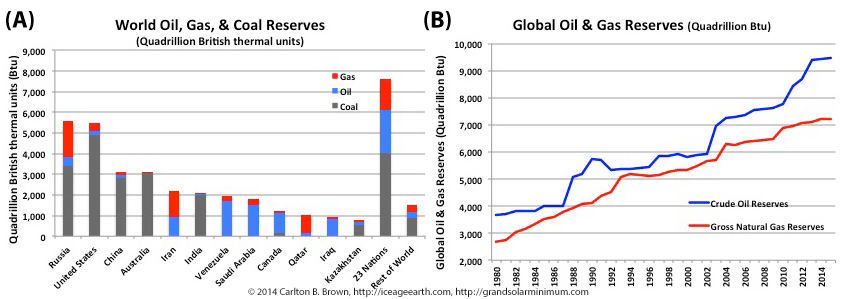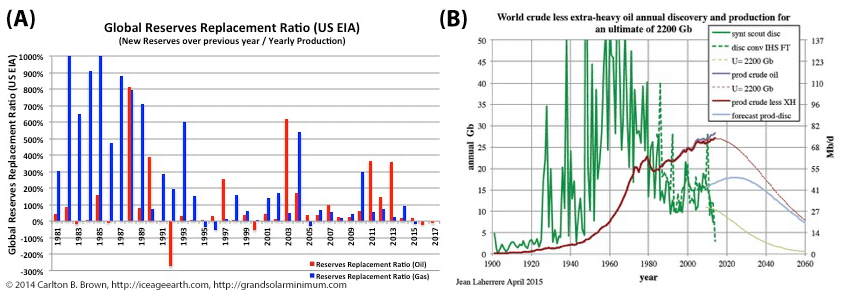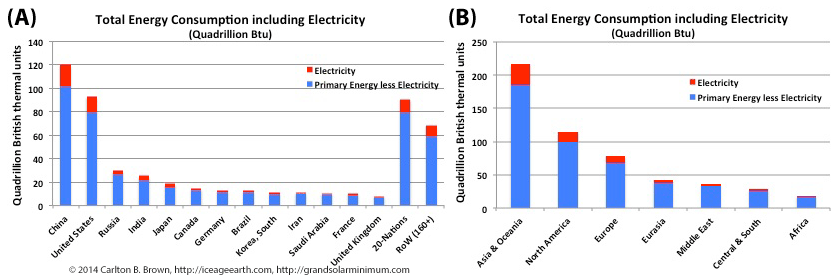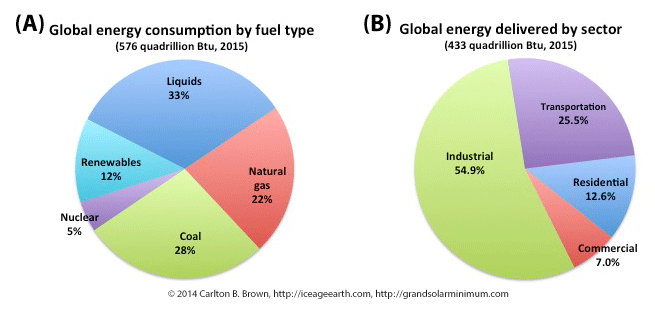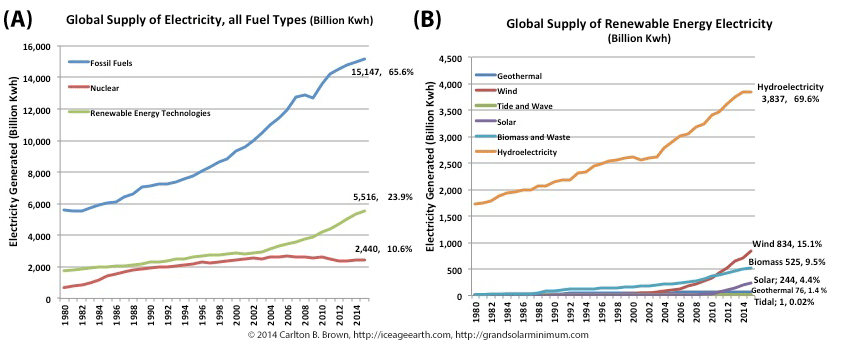Limited proven energy reserves
Peak oil and gas discovery is history
Growth accelerates the depletion of our energy reserves
Most energy consumption is by a minority of nations
World energy consumption by fuel type and sector
Energy system switch to renewables must accelerate
An energy crisis looms. There are only fifty years of proven oil and gas reserves remaining, while their peak discovery is history. Natural climate change risks remain unmitigated because UNFCCC and IPCC Articles 1 and 2 and IPCC business procedures dismissed these risks. A colder global climate will help accelerate fossil fuel reserve depletion and increase global geopolitical tensions.
World population and economic growth accelerated the depletion of world fossil fuel energy reserves, such that we only have 50 years of proven oil and gas reserves left.[i],[ii],[iii] Making matters worse is that 50 percent and 70 percent of the world’s oil and gas reserves are (respectively) in fact unproven guesstimates. This includes shale resources.[iv],[v]
The prospects for new oil and gas discoveries are not as bright as the promises made by the oil and gas industry might lead one to believe.[vi],[vii],[viii],[ix],[x] The profitable extraction of fossil fuels in the future will require higher oil and gas prices, rendering their extraction less attractive compared to lower risk, renewable energy investments.
How will the world’s nations provide for their energy needs in a colder world, while also facing severe pressures on their agricultural systems? What are you going to do for your children’s sake when you realize that peak oil and gas discoveries and production are things of the past?
What can we do about our collective, profligate insanity? How can the world rapidly prepare for a switch to a global cooling phase, and the risks this portends?
The second half of my book “Revolution: Ice Age Re-Entry” ambitiously attempts to answer these questions.
[i] Limited oil and gas reserves: IPCC, Climate Change 2014: Mitigation of Climate Change. Contribution of Working Group III to the Fifth Assessment Report of the Intergovernmental Panel on Climate Change [Edenhofer, O., R. Pichs-Madruga, Y. Sokona, E. Farahani, S. Kadner, K. Seyboth, A. Adler, I. Baum, S. Brunner, P. Eickemeier, B. Kriemann, J. Savolainen, S. Schlömer, C. von Stechow, T. Zwickel and J.C. Minx (eds.)]. Cambridge University Press, Cambridge, United Kingdom and New York, NY, USA. [Exposé: See page 379. The IPCC tells us that we have about 50 years of oil reserves and 70 years of natural gas reserves. They also confirm that energy discovery is more challenging and more costly, with a limited scope for profitable extraction of those reserves (i..e, extraction will require greater technology deployment). Question: How will humans generate the carbon dioxide required to produce the global warming predicted by the IPCC for the 21st century with only about 50 or so years of oil and gas left?].
[ii] Limited oil and gas reserves: IPCC, Climate Change 2007: Mitigation. Contribution of Working Group III to the Fourth Assessment Report of the Intergovernmental Panel on Climate Change [B. Metz, O.R. Davidson, P.R. Bosch, R. Dave, L.A. Meyer (eds)], Cambridge University Press, Cambridge, United Kingdom and New York, NY, USA. [Exposé: See page 265, section 4.3.1. This section details fossil fuels reserves, telling us the proven and probable oil and gas reserves will only last for decades, while coal will last for centuries. Question: How will humans generate the carbon dioxide required to produce the global warming predicted by the IPCC for the 21st century with only about 50 or so years of oil and gas left?].
[iii] Data. 50 years of proven oil and gas reserves (see Chapter 8): Energy Information Administration data was obtained from: International Energy Statistics. These calculations utilized the following data files. Natural gas https://bit.ly/2LC6GBo, Crude Oil https://bit.ly/2IWeEaP, Coal data https://bit.ly/2L6pk3w. [Comment: These reserve timeline estimates are calculated by dividing the 2013 Energy Information Agency’s proven global oil, natural gas, and coal reserves by 2013 levels of production. This calculation tells us there are 50 years of proven oil and gas, and 130 years of coal reserves left. These reserve timeline estimates do not assume any population or economic growth, or a switch to a cold climate regime, which would accelerate energy demand and reduce the timelines.].
[iv] U.S. Energy Information Administration report. Technically Recoverable Shale Oil and Shale Gas Resources. An Assessment of 137 Shale Formations in 41 Countries Outside the United States. June 2013. [Critique: See Table 2, page 3 for proven and unproven conventional and non-conventional energy reserves. The US Energy Information Agency reserve revisions mean that one-third of world gas and one-tenth of world oil resources are projections for shale resources. These revisions also mean that 50 percent and 70 percent of total conventional and unconventional oil and gas projections respectively are classified as unproven reserves (i.e., guesstimates). See pages 15-19, Methodology: These 2013 reserve revisions were based on predictions involving the application of historic US shale oil and gas recovery rates to foreign petroliferous basins with similar geophysical characteristics. These revisions assumed the same optimum operating context internationally as in the USA. See Chapter 8 for a more detailed critique on this tenuous assumption.].
[v] T.R. Klett et al., 2015, U.S. Geological Survey assessment of reserve growth outside of the United States: U.S. Geological Survey Scientific Investigations Report 2015–5091. http://dx.doi.org/10.3133/sir20155091. [Exposé: (1) See page 1; “The U.S. Geological Survey estimated volumes of potential additions to oil and gas reserves for the United States by reserve growth in discovered accumulations. These volumes were derived by using a new methodology developed by the U.S. Geological Survey.” (2) See page 4; Assessment of Reserve Growth Outside of the United States “Because recoverable volumes for individual reservoirs were not reported for many fields outside of the United States, the individual accumulation analysis was not used. Data acquired from individually analyzed U.S. accumulations were used as analogs in this study.” Critique: Significant increases in US fossil fuel reserves resulted from the deployment of new, non-validated forecasting methodology. Internationally, the reserve revisions were guesstimates, based on transferring historical precedents for the USA to overseas. None of these methods involved physically verifying the new reserves in the oil and gas wells or fields. That means these are unproven reserves].
[vi] All-time low for discovered resources in 2017: Around 7 billion barrels of oil equivalent was discovered. December 21, 2017. https://www.rystadenergy.com/newsevents/news/press-releases/all-time-low-discovered-resources-2017/.
[vii] Declining Reserve Replacement Ratios Deceiving In Resource Play Environment. November. 28, 2017. View Issue. Maurice Smith. JWN Energy. Daily Oil Bulletin. https://www.sproule.com/application/files/2415/1188/2978/Sproule-Declining-Reserve-Replacement-Ratios-Nora-Stewart-Steve-Golko.pdf.
[viii] Tom Whipple, Online article. “Peak Oil Review.” December 26, 2017. Originally published by ASPO-US. December 26, 2017. https://www.resilience.org/stories/2017-12-26/peak-oil-review-dec-26-2017/
[ix] Kjell Aleklett and Colin J. Campbell, “The peak and decline of world oil and gas production.” Minerals and Energy-Raw Materials Report 18.1 (2003): 5-20.
[x] Ian Chapman, 2014, “The end of Peak Oil? Why this topic is still relevant despite recent denials.” Energy Policy, 64 . 93-101. http://insight.cumbria.ac.uk/id/eprint/1708/.

